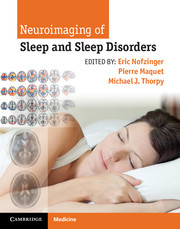Book contents
- Neuroimaging of Sleep and Sleep Disorders
- Neuroimaging of Sleep and Sleep Disorders
- Copyright page
- Contents
- Contributors
- Foreword
- Preface
- Section 1 Introduction
- Chapter 1 The role of neuroimaging in sleep and sleep disorders
- Chapter 2 Neuroanatomy and physiology of sleep and wakefulness
- Chapter 3 Fundamentals of structural MR imaging
- Chapter 4 Fundamentals of MRI for assessing brain function and metabolism
- Chapter 5 Fundamentals of PET scanning
- Chapter 6 Fundamentals of single-photon emission computed tomography (SPECT) and SPECT/CT imaging
- Chapter 7 Fundamentals of transcranial B-mode sonography
- Chapter 8 Fundamentals of magnetoencephalography
- Chapter 9 Fundamentals of low-resolution brain electromagnetic tomography
- Chapter 10 Methodology of combined EEG and fMRI
- Section 2 Neuroimaging of wakefulness and sleep
- Section 3 Neuroimaging, sleep loss, and circadian misalignment
- Section 4 Sleep and memory
- Section 5 Neuroimaging of sleep disorders
- Index
Chapter 5 - Fundamentals of PET scanning
from Section 1 - Introduction
Published online by Cambridge University Press: 05 March 2013
- Neuroimaging of Sleep and Sleep Disorders
- Neuroimaging of Sleep and Sleep Disorders
- Copyright page
- Contents
- Contributors
- Foreword
- Preface
- Section 1 Introduction
- Chapter 1 The role of neuroimaging in sleep and sleep disorders
- Chapter 2 Neuroanatomy and physiology of sleep and wakefulness
- Chapter 3 Fundamentals of structural MR imaging
- Chapter 4 Fundamentals of MRI for assessing brain function and metabolism
- Chapter 5 Fundamentals of PET scanning
- Chapter 6 Fundamentals of single-photon emission computed tomography (SPECT) and SPECT/CT imaging
- Chapter 7 Fundamentals of transcranial B-mode sonography
- Chapter 8 Fundamentals of magnetoencephalography
- Chapter 9 Fundamentals of low-resolution brain electromagnetic tomography
- Chapter 10 Methodology of combined EEG and fMRI
- Section 2 Neuroimaging of wakefulness and sleep
- Section 3 Neuroimaging, sleep loss, and circadian misalignment
- Section 4 Sleep and memory
- Section 5 Neuroimaging of sleep disorders
- Index
Summary
- Type
- Chapter
- Information
- Neuroimaging of Sleep and Sleep Disorders , pp. 31 - 40Publisher: Cambridge University PressPrint publication year: 2013
- 1
- Cited by



